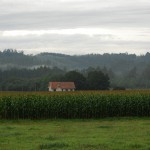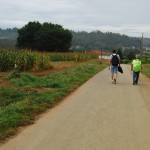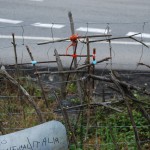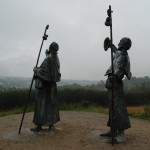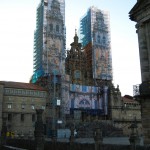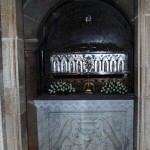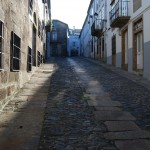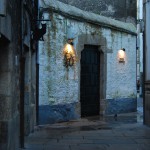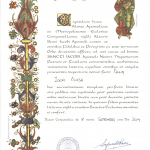Travelling in Spain: Camino Lugo—Santiago de Compostela. Part Five
In the morning, the whole sky was covered with clouds, and the air was filled with the anticipation of the rain. As we prepared for the journey, we decided not to eat breakfast there, but to have a bite somewhere along the way. Quickly packing our things and preparing ourselves to face the rain, we set off on our way.
Santiago de Compostela was nearly at hand from our hotel – just approximately 19 kilometres away. In this section, Camino Primitivo joins the Road of the French kings,1 and because of the numerous pilgrims and tourists it becomes “affluent.”
1(The Road of the French kings — is the main pilgrim route in the north of Spain, stretching for 675.5 kilometres from Pamplona to Santiago de Compostela).
Leaving the hotel behind us, we came to a country road. The road was winding, and crossed a motorway several times. After crossing the motorway again, we mingled with the mentioned unending flow of pilgrims. And if before, we had not practically met anybody, and we were happy to welcome any contact, even with domestic animals, now Camino turned into a crowded stream.
A little rain was sprinkling us from time to time on the way, casting us into a meditative mood. When we drew near Monte do Gozo, the rain became stronger and it started to pour down in buckets; but pilgrims are afraid of nothing, and we slowly but steadily approached our destination. The rain is not a frustration to a pilgrim, on the contrary, it is a blessing. On the way to Monte do Gozo we had to walk through a fairy-tale-like grove, where the ancient wide-spreading oak trees are growing, thoroughly covered with moss and lichen; there was a low chain-link fence, separating the grove and the pilgrims’ path from a busy motorway, with improvised crosses, left by the pilgrims, hanging all over the place.
People of all ages and sexes, of all nationalities, were moving on in a ceaseless, endless stream. Some walked faster, while others just trudged on with their canes, but all of them had joyful and inspired faces. On the one hand, we felt sad, because our fascinating journey was nearing its end, but on the other hand, we sensed some ease and freedom, as if, having walked this path, we finally rid ourselves of some heavy burden, that we had been carrying upon us for so long. For many people, especially for the old, their way of Saint James was a real act of heroism.
When we entered Monte do Gozo, we headed for the site, where, just like in the days of old, a view of the Cathedral in Santiago de Compostela reveals itself to the weary pilgrims. There is now a monument on this spot in the form of two bronze pilgrims; further away, in a distance, sunk in a grey haze, we saw the spires of Santiago de Compostela Cathedral towering over the horizon, where the resting place of Saint Apostle James is.
When we saw the main target of our pilgrimage, we decided to deviate a little from our route, and, following the insistent recommendations of our Spanish companion and guide Andrei, we visited a coastal town called Combarro, where, according to what he had told us, the best seafood dishes are cooked. Combarro and its vicinities deserve to be told about in a separate story.
…Santiago de Compostela in the evening welcomed us with its beautiful weather. When we lodged at our hotel, which was almost next to the Cathedral, and said our goodbyes to our accompanying guide Andrei, we decided to have a look at the city at night.
The streets of Santiago de Compostela were filled with people, and from every direction we could hear the exultant and cheerful voices. Some pilgrims were in tears, kneeling down, others were signing Christian hymns and praying. Some amazing energy was emanating from the main square of the Cathedral, and I felt like in just a little while I would ascend above the earth. I experienced something similar, when visiting the Church of the Nativity of Christ at Bethlehem.
After we walked in the evening city for a while, we decided to have supper, and our choice fell upon a restaurant at the hotel for pilgrims called Hostal dos Reis Catolicos (Hostel of the Catholic Kings). From 1510 till 1953, pilgrims from the whole world, including the most august persons, found refuge in this masterpiece of the architecture of the past.
During the supper, the decision was made to devote our early morning to the observation of the Cathedral and its relics, and of the sepulchre of Saint James, son of Zebedee, the heavenly defender and patron of Spain.
From the earliest morning, the communal services were preparing the city for a meeting with the new day, thoroughly mopping the streets, watering the flowerbeds, clearing the garbage and fallen leaves away. The Cathedral opened at about eight o’clock, and we were the first visitors.
At first, our guide Slava told us about the Cathedral of Santiago de Compostela itself, and about its history; then we looked at its relics that are kept in the Cathedral.
There is a tradition at the Cathedral, which has its roots going well back into the Middle Ages; here it is, exactly at five o’clock in the afternoon, all the pilgrims, who have arrived, meet in the Cathedral for a special service and offer up their praises to the Lord for empowering them to walk all this journey to the end. Saint Apostle James himself is present at the altar in three different personages: as a nobleman, as a soldier, and as a pilgrim. There are also four statues there, signifying the Four Virtues: Wisdom, Justice, Fortitude, and Temperance.
Most of all, the attendants will remember the ritual, which was carried out with a very original way of burning the incense — with the help of a special silver vessel one meter high. Within this huge censer are the burning coals and frankincense. From the highest point of the Cathedral a thick rope is hanging, to which this censer is fastened. Five husky Galician fishermen start rocking it to and fro with all of their strength. The censer is swishing over the heads of the attendants, spreading the aroma of the burning fragrance. This sight really makes a great impression, especially when this heavy thing gets in full swing. One day, in the distant year of 1622, the fishermen “dropped” the censer, and it crushed down. Fortunately, no one was injured…
After the interesting and thrilling story, we went down into the crypt, which is located under the main altar of the Cathedral, where the silver chest with the remains of Saint James is set. Having spent some time there in silence and meditation, and having prayed to Saint James, we proceeded to the upper section, built over the crypt, where the statue of Saint James is standing, and, following the old tradition, each one of us embraced the Saint’s statue and kissed the scallop, fixed on the back of the Saint.
After fulfilling all the necessary rituals, we came out of the Cathedral and headed for the Chapterhouse of the Cathedral of Santiago de Compostela, to the Keeper of the Seal of the Altar of Saint Apostle James, where our pilgrims’ passports (credenciale) were stamped with the final seals of the Cathedral of Santiago de Compostela, and we were given the certificates (compostelas), which stated that we devotedly and with Christian sentiments visited this Holiest Temple, and it was the conclusion – the last destination point of our pilgrimage to the tomb of Saint Apostle James, son of Zebedee.

